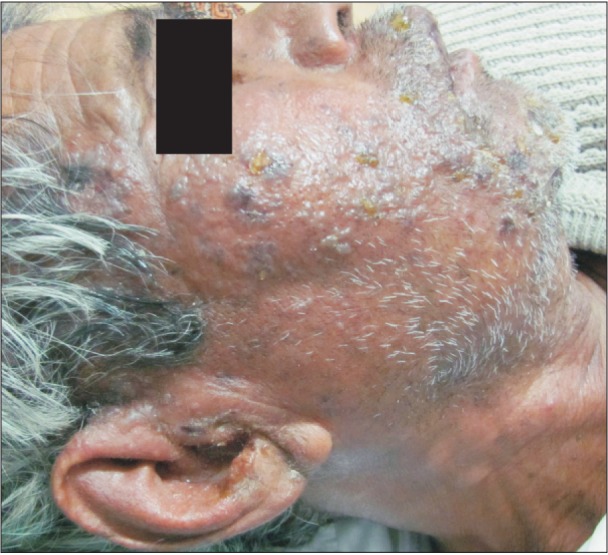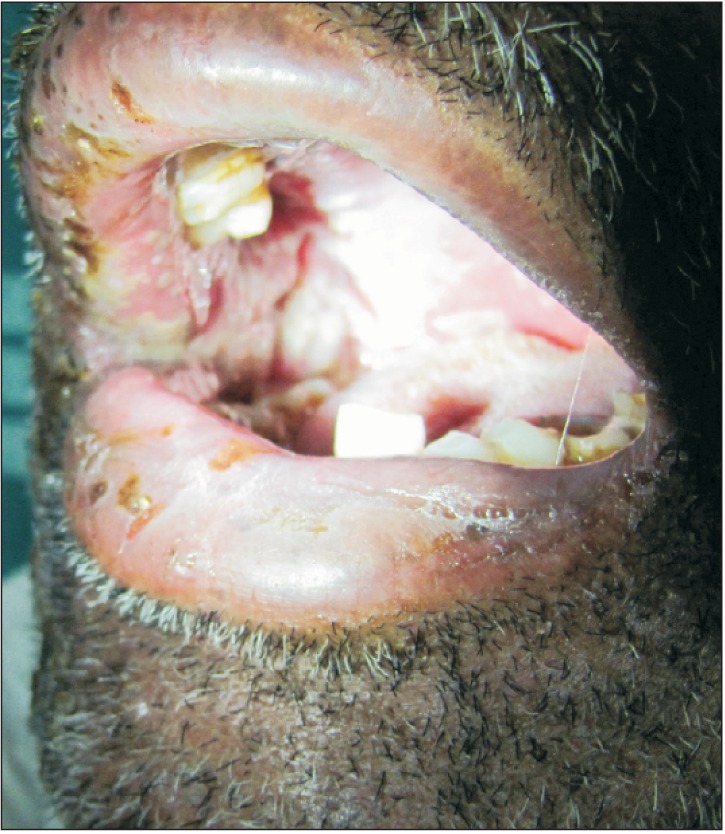J Korean Assoc Oral Maxillofac Surg.
2016 Jun;42(3):169-172. 10.5125/jkaoms.2016.42.3.169.
A little-known relationship between immune recovery syndrome and herpes zoster
- Affiliations
-
- 1Department of Oral and Maxillofacial Surgery, Sri Hasanamba Dental College and Hospital, Hassan, India. Supriyagb11@gmail.com
- 2Department of Orthodontics, Sri Hasanamba Dental College and Hospital, Hassan, India.
- 3Department of Oral Medicine, Sri Hasanamba Dental College and Hospital, Hassan, India.
- KMID: 2309261
- DOI: http://doi.org/10.5125/jkaoms.2016.42.3.169
Abstract
- Following anti-retroviral therapy (ART) or highly active antiretroviral therapy, there is an increased response to latent infections such as herpes zoster, which may lead to their reactivation. This is a result of improved immunity brought about by ART, also termed immune recovery syndrome. A 75-year-old male patient arrived at our institute with widespread vesicles and scabs on the right half of his face and oral cavity, suggesting the involvement of the trigeminal nerve. The patient had a history of being on ART two months earlier and a history of tooth extraction eight days prior to his arrival at our institute. The incidence of human immunodeficiency virus (HIV)-positive cases amongst herpes zoster cases is high, and these patients become susceptible to infections following ART. Therefore, regardless of the presence of risk factors, every herpes zoster patient should be tested for HIV infection, and high anti-retroviral therapy should be commenced/reinstituted as soon as possible. In addition, the treating physician should maintain a high level of vigilance for the patient during the first few months of ART, the peak incidence of immune recovery inflammatory disease.
MeSH Terms
Figure
Reference
-
1. Wiafe B. Herpes zoster ophthalmicus in HIV/AIDS. Community Eye Health. 2003; 16:35–36. PMID: 17491842.2. Gnann JW Jr. Varicella-zoster virus: atypical presentations and unusual complications. J Infect Dis. 2002; 186(Suppl 1):S91–S98. PMID: 12353193.
Article3. Immune reconstitution syndrome [Internet]. Washington (DC): AIDS InfoNet;cited 2015 Jun 15. Available from: http://aidsinfonet.org/uploaded/factsheets/85_eng_483.pdf.4. Immune Reconstitution Inflammatory Syndrome (IRIS) in HIVInfected Patients [Internet]. New York (NY): New York State Department of Health AIDS Institute;cited 2015 Jun 15. Available from: http://www.hivguidelines.org/clinical-guidelines/adults/immune-reconstitution-inflammatory-syndrome-iris-in-hiv-infectedpatients/.5. Martínez E, Gatell J, Morán Y, Aznar E, Buira E, Guelar A, et al. High incidence of herpes zoster in patients with AIDS soon after therapy with protease inhibitors. Clin Infect Dis. 1998; 27:1510–1513. PMID: 9868668.
Article6. Naveen KN, Tophakane RS, Hanumanthayya K, Pv B, Pai VV. A study of HIV seropositivity with various clinical manifestation of herpes zoster among patients from Karnataka, India. Dermatol Online J. 2011; 17:3. PMID: 22233739.
Article7. Millar EP, Troulis MJ. Herpes zoster of the trigeminal nerve: the dentist's role in diagnosis and management. J Can Dent Assoc. 1994; 60:450–453. PMID: 8004523.
- Full Text Links
- Actions
-
Cited
- CITED
-
- Close
- Share
- Similar articles
-
- Herpes Zoster Immune Reconstitution Inflammatory Syndrome in a HIV-infected Patient: Case Report and Literature Review
- Herpes Zoster Treated with Vidarabine-5-Monophosphate
- Ophthalmoplegia in Herpes Zoster Ophthalmicus
- Bilateral Vestibular Hypofunction Induced by Unilateral Herpes Zoster Oticus
- Recurrence Rate of Herpes Zoster during the Previous Decade




